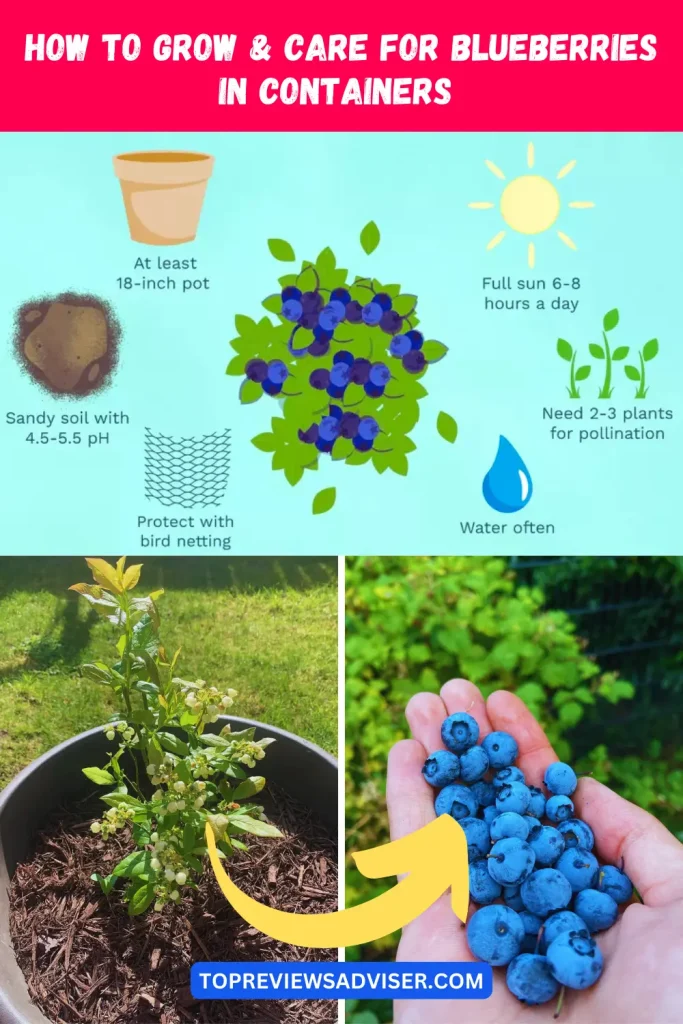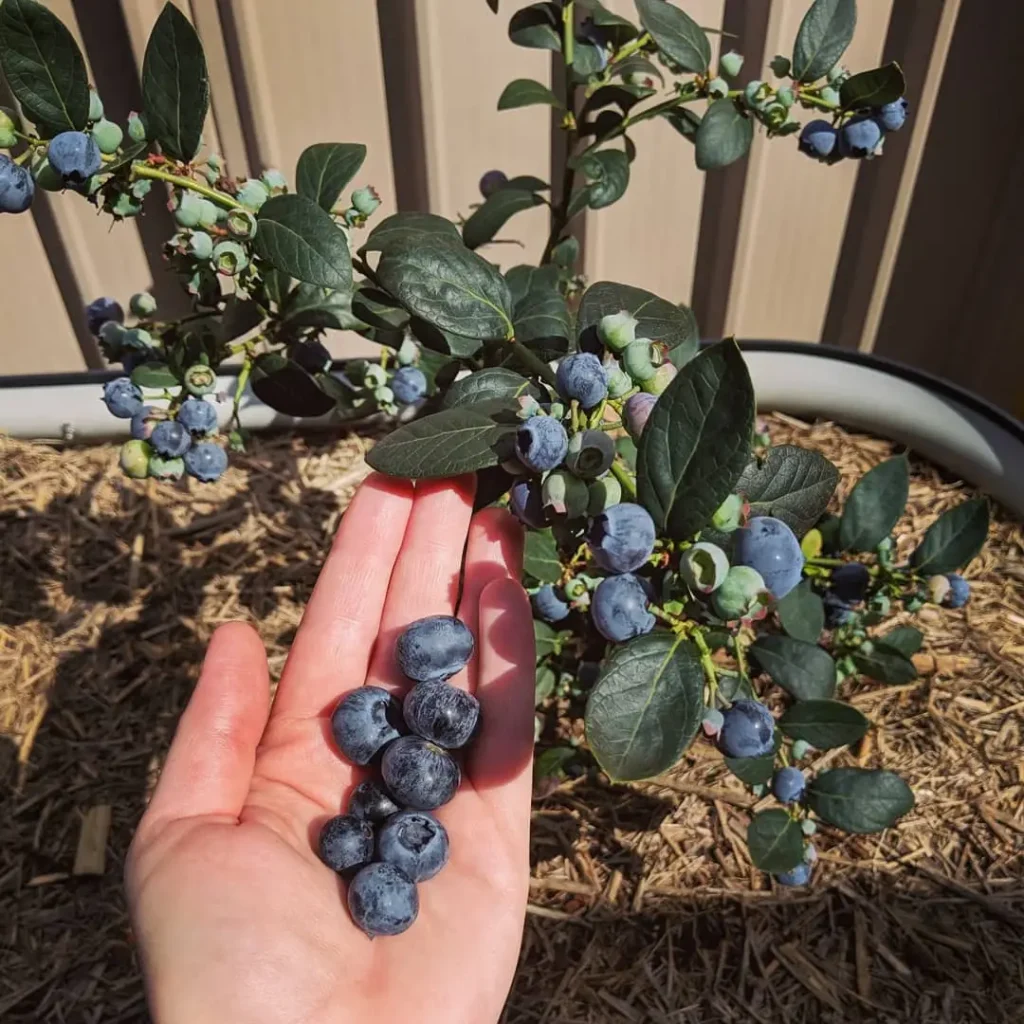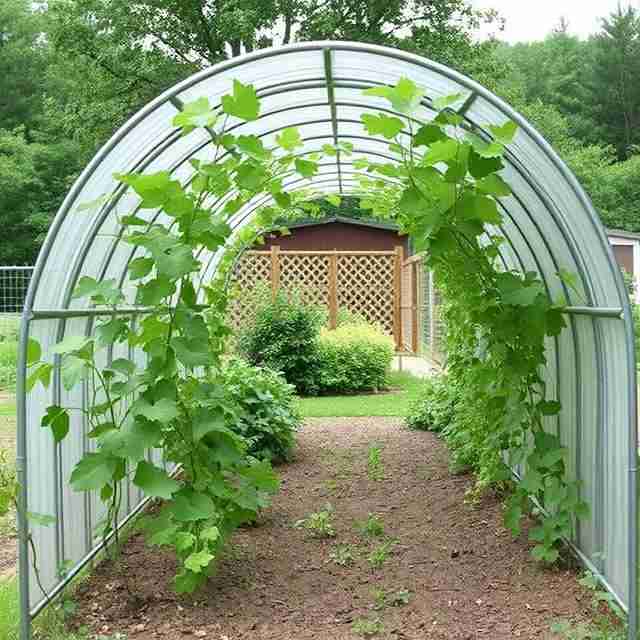How to Grow & Care for Blueberries in Containers
Blueberries are a delicious and nutritious fruit that can be easily grown in containers, making them a perfect addition to any home garden. Whether you are a seasoned gardener or just starting out, growing blueberries in containers can be a rewarding and enjoyable experience.
In this comprehensive guide, we will walk you through everything you need to know about how to grow and care for blueberries in containers.

| Common Name | Blueberry bush, rabbitteye, lowbush, highbush |
| Botanical Name | Vaccinium |
| Family | Ericaceae |
| Plant Type | Perennial shrub |
| Size | 24 in. to 4 ft., depending on variety |
| Sun Exposure | Full sun |
| Soil Type | Sandy and well-drained |
| Soil pH | Acidic (4.0-4.8) |
| Bloom Time | Summer |
| Hardiness Zones | 3-10 (USDA), depending on variety |
| Native Area | North America, South America, Europe, Asia |
Benefits of Growing Blueberries in Containers
Container gardening offers numerous advantages, including greater control over soil conditions, easier maintenance, and the ability to grow plants in limited spaces such as balconies or patios. Growing blueberries in containers allows you to enjoy fresh berries right at your fingertips, without the need for a large backyard garden.
How to Plant Blueberries in Containers
When it comes to planting blueberries in containers, there are a few key factors to consider to ensure the success of your plants.
When to Plant
The best time to plant blueberries in containers is in the early spring, once the last frost has passed. This will give the plants plenty of time to establish their roots before the hot summer months.
Selecting a Planting Site
When choosing a planting site for your blueberry containers, it’s important to consider the amount of sunlight the area receives. Blueberries thrive in full sun, so be sure to place your containers in a sunny spot that receives at least 6-8 hours of sunlight per day.
Spacing, Depth, and Support
When planting blueberries in containers, it’s important to provide them with enough space to grow. Each plant should have its own container, with a diameter of at least 18 inches.
The containers should also be deep enough to accommodate the plant’s root system, typically around 18-24 inches deep.
Additionally, some varieties of blueberries may require support as they grow, so be sure to provide stakes or trellises as needed.
Blueberries in Containers Care
Once your blueberries are planted, it’s important to provide them with the proper care to ensure their health and productivity.
Container Size

Choose containers that are at least 18 inches in diameter and depth to provide ample room for blueberry roots to spread. Ensure containers have sufficient drainage holes to prevent water buildup, which can lead to root rot.
Light
As mentioned earlier, blueberries thrive in full sun. Be sure to place your containers in a sunny location and rotate them regularly to ensure all sides of the plants receive adequate sunlight.
Soil
Blueberries prefer acidic soil with a pH level between 4.5 and 5.5. When planting blueberries in containers, be sure to use a well-draining potting mix specifically formulated for acid-loving plants.
Water
Blueberries require consistent moisture, especially during the growing season. Be sure to water your containers regularly, keeping the soil evenly moist but not waterlogged.
Temperature and Humidity
Blueberries prefer cooler temperatures and high humidity. Be sure to place your containers in a location with good air circulation to prevent humidity-related issues such as powdery mildew.
Fertilizer
Incorporate organic matter such as compost or aged manure into the potting mix to improve soil structure and fertility. Additionally, apply a slow-release fertilizer formulated for acid-loving plants to provide essential nutrients throughout the growing season.
Pollination
Some varieties of blueberries may require cross-pollination to produce fruit. If you are growing multiple varieties, be sure to plant them within close proximity to ensure proper pollination.
Types of Blueberries
There are several different types of blueberries available, each with its own unique characteristics and growing requirements. Some popular varieties include highbush, lowbush, and rabbiteye blueberries.
Blueberries vs. Bilberries
While blueberries and bilberries may look similar, they are actually two distinct fruits with their own unique flavors and growing habits. Blueberries are larger and sweeter, while bilberries are smaller and have a more intense flavor.
Harvesting Blueberries in Containers
Once your blueberry plants have matured, they will begin producing delicious fruit that is ready for harvest. Blueberries are typically ready to harvest in the summer months, once they have turned a deep blue color and are easily picked from the plant.
How to Grow Blueberries in Pots
Growing blueberries in pots is a great option for those with limited space or less-than-ideal growing conditions. With the right care and attention, blueberries can thrive in containers and produce an abundant harvest.
Proper Planting Depth and Spacing
Plant blueberry bushes at the same depth they were growing in their nursery containers, ensuring the crown of the plant is level with the soil surface. Space multiple blueberry plants at least 2 feet apart to allow for adequate air circulation and future growth.
Transplanting Established Blueberry Bushes into Containers
If transplanting established blueberry bushes into containers, carefully loosen the roots and trim any damaged or excessively long roots before planting. Water thoroughly after transplanting to help the plant establish itself in its new container environment.
Importance of Adequate Drainage
Proper drainage is crucial for container-grown blueberries to prevent waterlogged soil, which can lead to root rot and other fungal diseases. Elevate containers on pot feet or bricks to allow excess water to drain freely from the bottom.
Watering Frequency and Techniques for Container Blueberries
Water container blueberries regularly, keeping the soil consistently moist but not waterlogged. Check the soil moisture level regularly by inserting your finger into the soil; if it feels dry to the touch, it’s time to water.
Understanding Blueberry’s Sunlight Needs
Blueberries thrive in full sun, requiring a minimum of 6 to 8 hours of sunlight per day to produce abundant fruit. Position containers in a location with ample sunlight exposure, such as a south-facing patio or balcony.
Tips for Positioning Containers to Maximize Sunlight Exposure
Rotate containers periodically to ensure all sides of the plant receive equal sunlight exposure. Consider placing containers on wheeled carts or platforms for easy mobility, allowing you to adjust their position throughout the day as needed.
Regular Pruning for Healthy Growth
Prune container blueberries annually during the dormant season to remove dead or diseased branches and encourage new growth. Use sharp pruning shears to make clean cuts, and shape the plant to maintain its compact form.
Pest and Disease Management in Container Blueberries
Monitor container blueberries regularly for signs of pests such as aphids, spider mites, or fruit flies. Treat infestations promptly with organic insecticidal soap or neem oil, avoiding chemical pesticides that can harm beneficial insects.
Types of Fertilizers Suitable for Blueberries
Apply a balanced fertilizer formulated for acid-loving plants, such as a 10-10-10 or 12-12-12 blend, in early spring before new growth begins. Alternatively, use a specialized blueberry fertilizer containing micronutrients such as iron, sulfur, and manganese.
Frequency and Application Methods
Fertilize container blueberries once in early spring and again in late spring or early summer, following package instructions for dosage and application method. Avoid over-fertilizing, as this can result in excessive foliage growth at the expense of fruit production.
Harvesting Blueberries from Containers
Signs of Ripe Blueberries
Harvest blueberries when they are fully ripe and have developed a deep, uniform coloration. Berries should easily detach from the stem with a gentle tug, indicating they are ready for picking.
Proper Harvesting Techniques
Gently grasp ripe blueberries between your thumb and forefinger and twist them off the stem, being careful not to crush or bruise the delicate fruit. Store freshly harvested blueberries in the refrigerator for up to two weeks or freeze them for long-term storage.
Propagating Blueberries
If you’re interested in expanding your blueberry garden, you can easily propagate new plants from existing ones. This can be done through methods such as hardwood cuttings or layering.
Growing Blueberries From Seeds
While it is possible to grow blueberries from seeds, it is not the most common method of propagation. Blueberry seeds can be slow to germinate and may not produce fruit true to the parent plant.
- Seed Preparation: Place the blueberry seeds in the freezer for approximately 90 days. This stratification period helps break dormancy and prepares the seeds for germination.
- Sowing Seeds: After stratification, remove the seeds from the freezer and prepare a flat tray filled with moist sphagnum moss. Gently sprinkle the seeds evenly over the surface of the moss, then lightly cover them with a thin layer of additional moss.
- Covering and Placement: Cover the tray with newspaper to create a dark, humid environment conducive to germination. Position the tray in an area that maintains a consistent temperature between 60 and 70 degrees Fahrenheit.
- Maintaining Moisture: Ensure the moss remains consistently moist throughout the germination period. Avoid overwatering, which can lead to rot, but also prevent the moss from drying out completely. With proper moisture levels, you should start to see seedlings emerging in approximately a month.
- Light Exposure: Once the seedlings emerge, remove the newspaper cover but continue to provide bright, indirect light to encourage healthy growth. Avoid exposing the delicate seedlings to direct sunlight, as this can cause stress or sunburn.
- Transplanting Seedlings: Once the seedlings have grown a few inches tall and developed sturdy roots, they can be transplanted into larger containers filled with a moist mixture of peat moss, sand, and soil. Ensure the growing medium is well-draining and nutrient-rich to support continued growth.
Overwintering
In colder climates, it’s important to take steps to protect your blueberry plants from harsh winter conditions. This may include insulating the containers or moving them to a sheltered location.
Protecting Blueberry Plants During Winter
Container blueberries are more susceptible to freezing temperatures than those planted in the ground. Insulate containers with mulch or straw to protect the roots from frost damage, and consider wrapping the containers with burlap or frost blankets during severe cold snaps.
Winter Care Tips for Container Blueberries
Reduce watering frequency during the dormant season to prevent waterlogged soil, but ensure containers remain adequately moist. Prune container blueberries lightly in late winter to remove any dead or damaged branches and promote vigorous spring growth.
Common Pests and Plant Diseases
Like any plant, blueberries are susceptible to a variety of pests and diseases. Be on the lookout for issues such as aphids, mites, and fungal infections, and take appropriate measures to address them as needed.
Addressing Yellowing Leaves
Yellowing leaves on container blueberries can indicate nutrient deficiencies, water stress, or soil pH imbalances. Conduct a soil test to determine the underlying cause, and adjust fertilizer applications or pH levels accordingly.
Dealing with Pests and Diseases
Monitor container blueberries regularly for signs of pest infestations or fungal diseases, such as powdery mildew or leaf spot. Remove affected leaves or branches promptly, and treat with organic fungicides or insecticides as needed to prevent spread.
Advantages of Container Blueberry Gardening
Accessibility and Convenience
Container blueberry gardening allows you to grow fresh, flavorful berries right outside your door, eliminating the need for a large garden plot. Containers can be placed on patios, balconies, or even windowsills, making them accessible to gardeners of all skill levels.
Space-Saving Benefits
Container gardening is ideal for urban dwellers or those with limited outdoor space, allowing you to maximize vertical and horizontal space by stacking or grouping containers. Blueberries grown in containers also tend to produce higher yields per square foot compared to traditional garden beds.
Incorporating Blueberries into Small Spaces
Creative Container Ideas for Urban Gardens
Get creative with container choices for growing blueberries in small spaces, such as repurposing old barrels, buckets, or wooden crates. Consider vertical gardening techniques such as trellises or hanging baskets to make the most of limited space.
Companion Planting with Blueberries
Companion planting blueberries with compatible herbs, flowers, or vegetables can help attract beneficial insects, improve soil health, and enhance overall garden biodiversity. Consider planting blueberries alongside strawberries, rhubarb, or basil for a mutually beneficial garden ecosystem.
Tips for Success with Container Blueberries
Regular Monitoring and Care
Monitor container blueberries regularly for signs of moisture stress, nutrient deficiencies, or pest infestations, and address any issues promptly to prevent further damage. Keep an eye on weather conditions and adjust watering and protection measures as needed.
Learning from Experience and Adapting Techniques
Container gardening is as much art as it is science, and each gardener’s experience will vary based on factors such as climate, soil conditions, and plant variety. Experiment with different container sizes, soil mixes, and growing techniques to find what works best for your unique growing environment.
FAQs
1. Can I grow blueberries in containers indoors?
While blueberries prefer outdoor growing conditions, you can grow them indoors if you provide adequate sunlight and humidity levels. Consider placing containers near south-facing windows or using supplemental grow lights to ensure sufficient light exposure.
2. Do blueberries grown in containers require pollination?
Yes, blueberries grown in containers, like those planted in the ground, require pollination to produce fruit. Bees and other pollinators will typically visit container blueberries, but you can also hand-pollinate flowers using a small brush or cotton swab to ensure adequate fruit set.
3. How often should I repot my container blueberries?
Container blueberries may need repotting every 2 to 3 years to refresh the soil and provide additional space for root growth. Choose a slightly larger container each time you repot, and carefully transplant the blueberry bush during the dormant season for best results.
4. Can I grow blueberries in the same container as other plants?
While it’s possible to grow blueberries alongside other plants in a mixed container, it’s important to choose companion plants that have similar soil and sunlight requirements. Avoid overcrowding the container, and select companion plants that won’t compete with the blueberries for nutrients or space.
5. Are there any specific pruning techniques for container blueberries?
When pruning container blueberries, focus on removing dead, damaged, or overcrowded branches to improve air circulation and promote healthy growth. Aim to maintain a balanced, open-centered shape, and avoid excessive pruning that may reduce fruiting potential.
Bottom Line
Growing blueberries in containers can be a fun and rewarding experience for gardeners of all skill levels. With the right care and attention, you can enjoy a bountiful harvest of delicious blueberries right from your own backyard.
Whether you’re a seasoned gardener or just starting out, consider adding blueberries to your container garden for a beautiful and fruitful addition.





